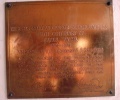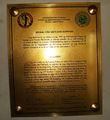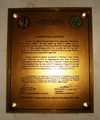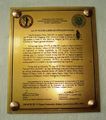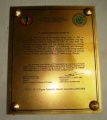Palma Hall: Difference between revisions
| Line 19: | Line 19: | ||
Palma Hall used to be the home of the College of Liberal Arts, at present, it is more commonly known as "AS", and currently houses the College of Social Sciences and Philosophy. It was named after Rafael Palma (1874-1974), who served as president of the university from 1923 to 1933. Rafael Palma formally assumed the Presidency of the University of the Philippines on July 18, 1925 after having served as acting President for nearly two years. | Palma Hall used to be the home of the College of Liberal Arts, at present, it is more commonly known as "AS", and currently houses the College of Social Sciences and Philosophy. It was named after Rafael Palma (1874-1974), who served as president of the university from 1923 to 1933. Rafael Palma formally assumed the Presidency of the University of the Philippines on July 18, 1925 after having served as acting President for nearly two years. | ||
Before the start of the first semester of the academic year 1959-1960, the College of Liberal Arts was reorganized into three academic units -the University College, the College of Arts and Sciences and the Graduate School of Arts and Sciences. All three units, however, were served by only one faculty | Before the start of the first semester of the academic year 1959-1960, the College of Liberal Arts was reorganized into three academic units -the University College, the College of Arts and Sciences and the Graduate School of Arts and Sciences. All three units, however, were served by only one faculty. | ||
The College of Liberal Arts was reorganized in order to solve the problem that may result with the implementation of the basic education program. The University College started its operations during the first semester of 1959-1960. It was given the task of teaching the general education courses, including the humanities, social sciences and natural sciences, for the first two years. To strengthen the foundation of a liberal education, the college was expected to continue the general education, as well as to correct some aspects taught in high school. | The College of Liberal Arts was reorganized in order to solve the problem that may result with the implementation of the basic education program. The University College started its operations during the first semester of 1959-1960. It was given the task of teaching the general education courses, including the humanities, social sciences and natural sciences, for the first two years. To strengthen the foundation of a liberal education, the college was expected to continue the general education, as well as to correct some aspects taught in high school. | ||
Revision as of 09:56, 14 September 2009
Palma Hall
Art Studies 2 THR-2
Sir Robert G. Paulino
Report by:
Ina Camua
Karina Gonzales
Sharmaine Gonzales
PAGE STILL UNDER CONSTRUCTION
I. History of Palma Hall/Arts and Sciences
-
Plaque commemorating the birth centenary of Rafael Palma (AS Lobby)
Palma Hall used to be the home of the College of Liberal Arts, at present, it is more commonly known as "AS", and currently houses the College of Social Sciences and Philosophy. It was named after Rafael Palma (1874-1974), who served as president of the university from 1923 to 1933. Rafael Palma formally assumed the Presidency of the University of the Philippines on July 18, 1925 after having served as acting President for nearly two years.
Before the start of the first semester of the academic year 1959-1960, the College of Liberal Arts was reorganized into three academic units -the University College, the College of Arts and Sciences and the Graduate School of Arts and Sciences. All three units, however, were served by only one faculty.
The College of Liberal Arts was reorganized in order to solve the problem that may result with the implementation of the basic education program. The University College started its operations during the first semester of 1959-1960. It was given the task of teaching the general education courses, including the humanities, social sciences and natural sciences, for the first two years. To strengthen the foundation of a liberal education, the college was expected to continue the general education, as well as to correct some aspects taught in high school.
Meanwhile the third and subsequent years of college studies were handled by the College of Arts and Sciences which was mandated to continue offering undergraduate courses in the humanities, social scien-ces, natural and physical sciences, mathematics and languages. These disciplines were offered by the college as fields of specialization. As such, the third and subsequent years of college studies of a student were focused on one discipline for in-depth study, aside from other related disciplines, called free electives, which he may rake.
The different roles played by the University College and the College of Arts and Sciences necessitated separate administrations. To avoid the overlapping of roles of the two colleges and to integrate the various disciplines, three major divisions were formed to take the place of the academic departments -- the Division of Humanities, Division of Social Sciences, arid the Division of Natural Sciences. The traditional academic disciplines operated under their respective divisions without any departmental head
On 26 October 1983, the UP Board of Regents issued Administrative Order No.170 creating three new colleges from the former College of Arts and Sciences - the College of Social Sciences and Philosophy (CSSP), ripe College of Arts and Letters (CAL), and the College of Science (CS). [1]
II. Parts of AS
A. AS Lobby
-
Plaque found below the AS Mural
The mural at the AS Lobby, titled "The Arts and Sciences", was made by National Artist, Vicente Manansala in 1960. With a length of 14 meters and a width of 2 meters, "The Arts and Sciences" is the biggest mural in the UP Diliman Campus.
The floor of the AS Lobby has a terrazzo granolithic design.
-
Plaque found outside the "Basement"
AS Canteen - known at present as the "Basement", the AS Canteen used to be the mneeting place of the artists and scientists of UP where they used to hold intelecctual debates in the 60's and 70's. Some of the topics were Existentialism and Marxism. A prominent figure in the canteen was Salome Flores, more popularly known among the students as "Mommy". The canteen was closed in the 90's. At present, it serves as the office of the Archeological Studies Program.
-
Plaque at the AS 2nd floor Lobby
AS 2nd floor Lobby - during the latter part of the 70's, the AS 2nd floor Lobby became known as the "Second Floor Republic" among the student activists. It served as the 'tambayan' of three activist fraternities/sororities; the Pi Sigma/Pi Sigma Delta, the Sigma Kappa Pi/Sigma Delta Pi, and the Alpha Sigma/Sigma Alpha Nu, and other organizations such as Kalilayan, Asylum and Kutang Bato.
AS 209 - served as the office of the UP President from 1951-1956. Used by then UP President, Vidal A. Tan.
AS 207 - served as the meeting place of the Consultative Committee on Student Affairs (CONCOMSA) from 1974-1975. The CONCOMSA was a group of students in charge of preparing the return of the UP Student Council (USC) which was abolished during the Martial Law in 1972. It also served as the office of the AS Student Council, SINAG and the Freshmen Orientation Program Committee (FOPC).
-
Plaque beside "Mga Natatanging Pilipino"
2nd floor Mural "Mga Natatanging Pilipino" - the mural was made by the UP Artists' Circle Fraternity in 1996. It features exceptional Filipinos who played important roles in the Propaganda Movement (1882-1892), the EDSA Revolution (1986) and other student leaders.
B. AS Steps
C. AS Walk
D. Libraries
The Third World Studies Center is found along the AS Walk. The Third World Studies Center (TWSC) of the University of the Philippines is an academic research institute based at the College of Social Sciences and Philosophy (CSSP), committed to analyze and develop alternative perspectives on Philippine, regional and global issues. [2]
E. Theaters
-
Plaque outside the Guerrero Theatre (AS 2nd floor Lobby, UP Diliman)
Found at the AS 2nd floor Lobby, the Wilfrido Ma. Guerrero Theatre is dedicated to the former director of the UP Dramatic Club, Wilfrido Ma. Guerrero, "whose works as a playwright for over two generations... have given (the) theatre an epoch of Philippine drama that will remain a part of (the Filipinos') heritage." It was first opened on September 16, 1976. Renovation of the theatre was completed in the year 2000 through the efforts of Claro T. Llaguno (UP Diliman Chancellor, 1996-1999), Emerlinda Roman (UP Diliman Chancellor, 1999-2000) and Leonor M. Briones (Treasure of the Philippines, Bureau of the Treasury).
F. Museums
-
Plaque outside the Anthropology Museum (AS 2nd floor)
The Anthropology Museum, found at the AS 2nd floor, was opened on July 13, 1967 through the efforts of then University Secretary, Iluminada Panlilio. Its first exhibit featured Prof. H. Otley Beyer's collection of archeological and ethnological artifacts. The said collection was first featured in 1668 at the Museum and Institute of Archeology and Ethnology in Aviles Street, Manila which was destroyed during the 2nd World War. Natividad Noriega, Beyer's personal secretary, served as the museum's first curator.
III. Departments and Offices in AS
A. AS 101
AS 101 is the Office of the College Secretary for CSSP. This is where students can get their TCG (True Copy of Grades), dropping slips, ChangeMat slips (Change of Matriculation), and registration materials (Form 5 and Form 5A) during enrolment.
B. CSSPSC Office
The CSSP Student Council Office is located on the first floor of the West Wing of Palma Hall. Aside from being the office of the college council, it also has a student lounge, and students are allowed to borrow books from their collection.
C. Geog Information System Lab
D. OSA
The Office of Student Affairs oversees various student services and activities. Its duties are as follows: (source: http://web.kssp.upd.edu.ph/osa/history.html)
a. To render guidance and counseling services
b. To coordinate student groups and activities
c. To serve as a center where students can feel free to drop in for any form of assistance; where their complaints are heard and acted upon; and where they can be provided with clear and adequate information on college rules.
The OSA is where students can make reservations for rooms in Palma Hall, and where posters to be posted in the campus are submitted for approval.
E. Graduate Program (PH 111)
PH 111 is the office of the college’s Graduate Program. This is for students who have finished their undergraduate studies and would like to take up their Masters or Doctorates in CSSP.
F. Office of the Dean
The Office of the Dean is found on the first floor of Palma Hall, in the AS Lobby.
G. Sinag Office
H. UPDGO (Benton Hall)
The UP Diliman Gender Office is a unit under the office of the Chancellor, which is mandated to promote gender rights as human rights. Their office is found on the second floor of Benton Hall. Students may come here if they need counseling and assistance regarding gender-related matters and problems.
I. OASH (Benton Hall)
The Office of Anti-Sexual Harassment is found on the second floor of Benton Hall. OASH is where students may file any sexual harassment/assault complaints.
J. DZUP (Room 134)
Formed by Prof. Consuelo V. Fonacier of the Department of Speech and Drama, the DZUP office used to be in Palma Hall. It was originally a lab and transmitter project of the Department of Electrical Engineering. The lab was transferred to the Arts and Sciences while the transmitter remained at the College of Engineering. Prof. Leticia H. Tison created the curriculum for Radio Broadcasting which is now still a part of the Department of Speech Communication and Theater Arts. During the Diliman Commune in 1971, DZUP was used by the activists where they read poems by Amado V. Hernandez. The DZUP office was transferred to the College of Mass Communication in 1987.
IV. Other Tri-College Buildings
A. PHAn
B. CAL
C. Science Pavillions

